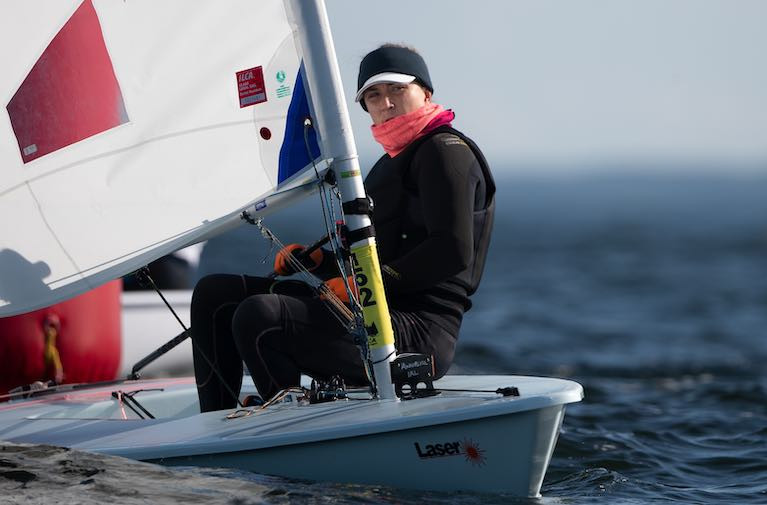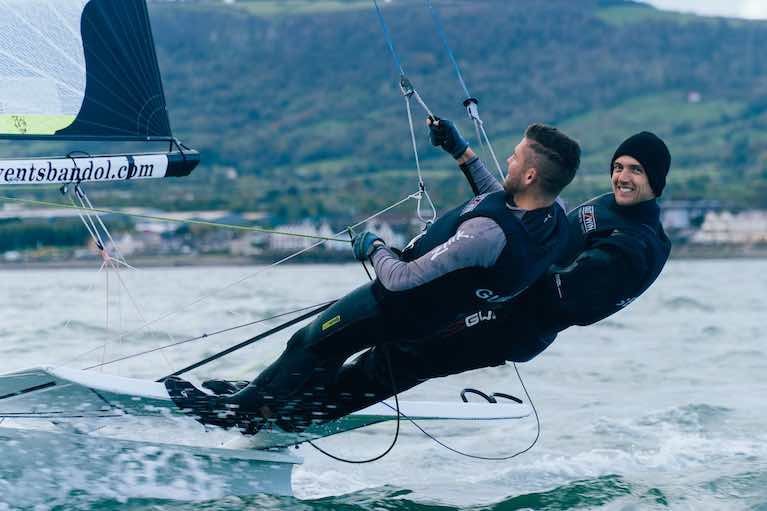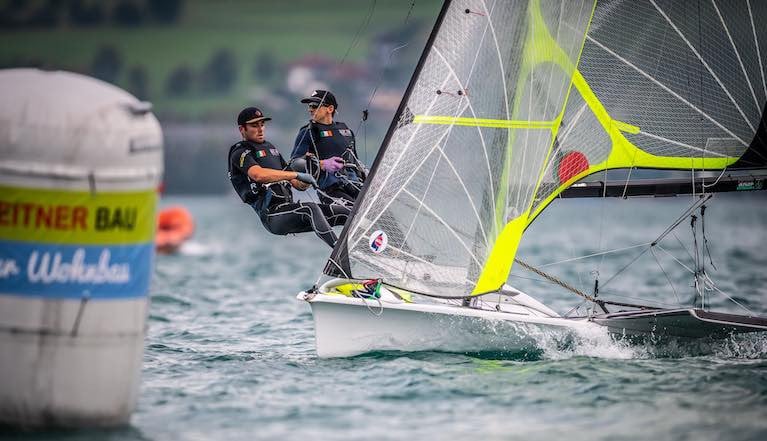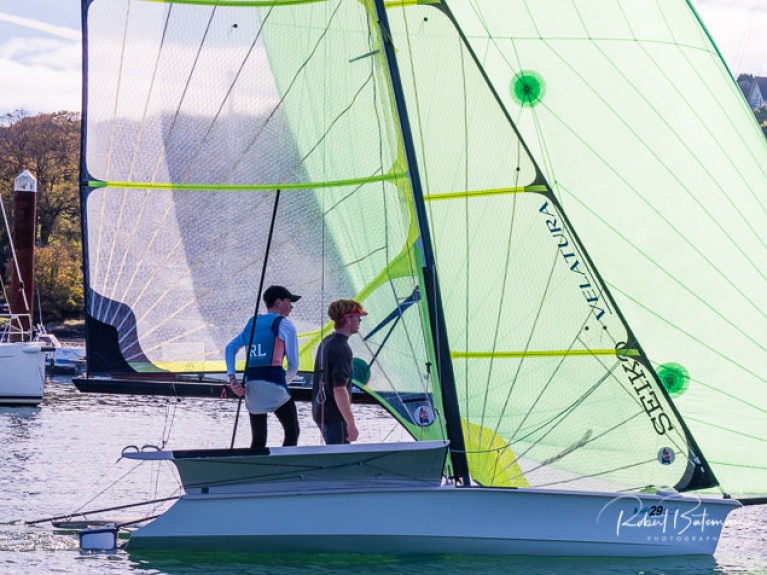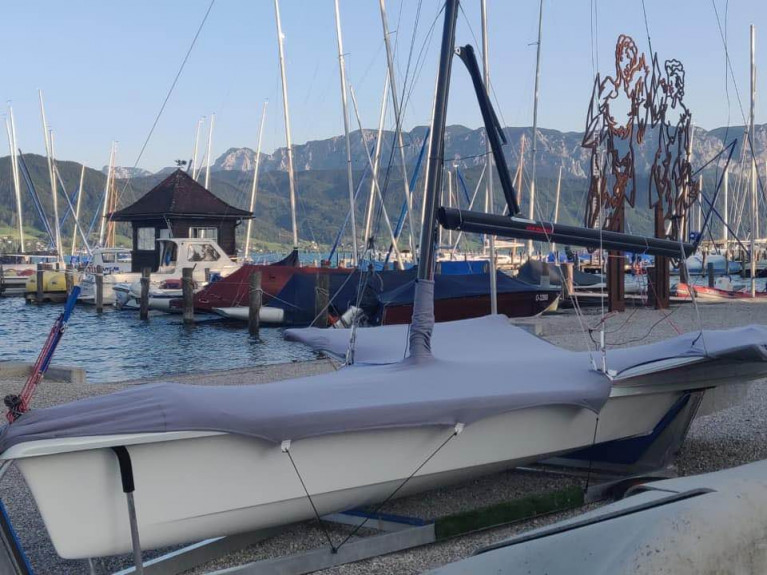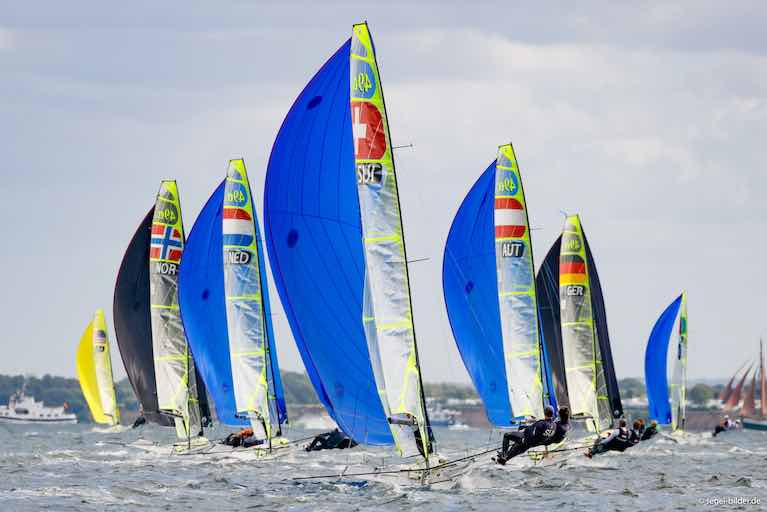Displaying items by tag: 49er
Olympic Federation Updates on Irish Sailors Looking to Qualify in 49er & Laser for Tokyo 2021
The Olympic Federation of Ireland (OFI) say in an update that Irish athletes across most sports are still on the qualification journey for the Tokyo Olympic Games which now take place next year from 23 July to 8 August 2021. Sailing is no different with only one of a possible three confirmed so far.
To date, there are 52 confirmed athlete spots for Tokyo, with many more athletes and teams sitting inside qualification status.
Eleven sports to date will enjoy Irish representation in Tokyo, and the current tracking of the team could see Team Ireland travelling next summer to Tokyo with the largest Olympic team to date.
In sailing, Ireland has already qualified one boat for Tokyo – the Women’s Laser Radial, which was achieved via Aisling Keller at the World Championships in 2019 – this position is set to be filled by Annalise Murphy, who has been nominated by Irish Sailing after a cut-short trial that left both Keller and Howth rival Aoife Hopkins 'devastated'.
'Selection', say the OFI, will be made once the process has been completed.
 Seafra Guilfoyle (left) and Ryan Seaton are one of two Irish 49er campaigns looking for the last nation berth for Tokyo 2021
Seafra Guilfoyle (left) and Ryan Seaton are one of two Irish 49er campaigns looking for the last nation berth for Tokyo 2021
There are still limited opportunities for Ireland to qualify another boat – the 49er can still qualify at the planned European Sailing Cup where one spot is available. As Afloat reported earlier, Ireland is vying with Belgium, Sweden and Italy for the one remaining European place. Form at the 2020 Worlds suggested that Irish sailors would be favourites having finished ahead of the other three candidates.
 Laser sailor Finn Lynch, one of three Irish helmsmen seeking a final nation berth for Tokyo 2021
Laser sailor Finn Lynch, one of three Irish helmsmen seeking a final nation berth for Tokyo 2021
In the Men’s Laser, there are two spots available at the planned European Sailing Cup. Up to six countries are in the running – Slovenia, Switzerland, Spain, Netherlands and Belgium and Ireland with Ireland finishing behind all of these at the latest World Championships.
In both of these events, the majority of spots were available at the World Championships in 2019 but unfortunately, Ireland missed out.
As Afloat reported in back in March the IOC, in their determination to maintain normality – or to return to normality as soon as possible – have issued a position update on the 2020 Tokyo Olympics and the potential changes to the qualification process disrupted by the spread of Covid-19.
Many sports, including sailing, have had to cancel qualifying events and the IOC has asked International Federations to consider revising the qualification process which may include ranking or historical results. More on this here.
Northern Ireland Olympian Ryan Seaton Says New Slipway at Carrickfergus Sailing Club is a 'Game-Changer'
Olympic sailor Ryan Seaton is back training at his home club in Carrickfergus on Belfast Lough following the completion of a slipway widening project.
In past campaigns Ryan has had to train away from home because the slipway at Carrickfergus was unsuitable for launching a high-performance dinghy.
Part-funded by Mid and East Antrim Borough Council, the new slipway means Ryan, who represented Ireland in the 49er Class at the London 2012 and Rio 2016 Olympic Games, can now launch safely and undertake his winter training on familiar waters for the first time as he bids for a place at next year's games in Tokyo.
With qualification for the much-anticipated competition just around the corner, Ryan and his crew, Seafra Guilfoyle from Royal Cork YC and University College Cork Sailing Club, are busy training and making plenty of use of the new slipway as Seaton aims for this third Olympics in a row. The duo competed in Austria at Lake Attersee last month to battle it out at the Europeans, as Afloat reported here.
 The newly widened slipway at Carrickfergus Sailing Club
The newly widened slipway at Carrickfergus Sailing Club
Ryan said "Carrickfergus and Belfast Lough is one of the best sailing locations throughout the UK and Ireland but I was unable to take full advantage of training on it due to the lack of a slipway suitable for my dinghy. This new facility is an absolute game-changer for me and will make a huge difference as I can now continue my professional sailing career at my home club and complete some vital training ahead of Tokyo 2021 qualification".
He continued "My thanks are extended to Carrickfergus Sailing Club and Mid and East Antrim Borough Council for making this possible and improving my training opportunities."
Mayor of Mid and East Antrim, Councillor Peter Johnston said the initiative will be a boost to the entire sailing community. "As a Council, we are proud to be able to assist with this very worthwhile project and wish Ryan every success as he aims for next year's Olympic games. This new feature is a boost to both the Club and other users and will hopefully inspire others to get involved and may even produce a few future Olympians."
Northern Ireland Olympic Sailor Ryan Seaton Preparing for Busy Training Season Ahead
Northern Ireland sailor Ryan Seaton from Ballyholme Yacht Club on Belfast Lough, took to the water at Lake Attersee, Austria, earlier this month to battle it out at the Europeans with the other half of his 49er duo Seafra Guilfoyle from Royal Cork Yacht Club.
They finished 26th in the 55-boat fleet in the event which took place from 28 September to 4 October - no mean feat after a difficult few months.
The pair have been able to get only 30 days' sailing in the last six months due to Covid-19 restrictions. Setting out for their journey to compete in Austria, they also had to borrow kit as theirs is still on its way home from Palma after competing there earlier in the year.
Seaton explains that the Europeans were very different to the usual event: "With it being COVID19 times, it made big changes to the racing; we didn't have any measurement or social gathering at all. Masks on and no hugging, though it was great to see all the other sailors from the big Olympic family."
Commenting on their result, Seaton says: "We were happy with how well we sailed under all the circumstances and to be racing in the gold fleet with others who have sailed more and who were using their Olympic kit. To say conditions were shifty is an understatement. We had 60-degree wind shifts and many times we couldn't cross the start line on starboard tack. The event organisers did a great job under the circumstances. Seafra and I kept really positive. We used this event as an opportunity to get more hours on the water, in preparation for next year's Olympic qualification in Palma."
While it is difficult to plan in the current Covid-19 climate, the pair are looking ahead to 2021 and preparations are underway.
They plan to sail in Ireland until the beginning of December and then travel to Villamoura in Portugal to race in better conditions alongside international teams and log quality hours. They will then move down to Palma until April to take part in camps and sail at a small club regatta, working towards the Palma Regatta, an Olympic Qualification event at the end of March.
Seaton comments: "We are super motivated now to get lots of hours on the water. We aim to get 20 days a month completed and we are in the process of getting our kit all back home and sorted in preparation for next year."
RYA Northern Ireland's Performance Manager Andrew Baker says Seaton is on course to a solid year of racing ahead.
"This was Ryan's first real event of the season and was a fantastic opportunity to compete in a world-class field. He has now got a feel for the fleet and his strengths and weaknesses within it. RYA Northern Ireland is pleased that Ryan can now enter the Winter training phase with a clear pathway and goals to achieve."
Optimist Ace James Dwyer Matthews Takes a Tack in an Olympic 49er
Despite Royal Cork Yacht Club's Seafra Guilfoyle's super efforts at the sharp end of Ryan Seaton's 49er campaign for Tokyo 2021 next year, there's been little in the way of Olympic skiff sailing going on in Guilfoyle's home port for the past two seasons.
These fast and tricky skiffs are a handful for most and this has put them on a downward spiral in Cork Harbour.
So it was interesting to spot Optimist and Laser 4.7 ace James Dwyer Matthews of RCYC trying out a 49er (one of two in active use), with Chris Bateman of Monkstown Bay as his crew.
Guilfoyle, a 2014 world youth silver medalist, meanwhile, continues his campaign for selection in the 49er and is vying with a Dublin crew to win a single Irish berth against stiff competition for one of the final slots available for Japan.
Howth's Dickson & Waddilove in 18th are Top Irish 49er at Europeans on Lake Attersee
In the hunt for the last Olympic berth for Toyko next year, the Irish under-23 duo of Robert Dickson and Sean Waddilove have, for a second time in a fortnight, beaten double Olympian Ryan Seaton sailing with Seafra Guilfoyle at an international regatta.
In their first Olympic campaign, the Howth and Skerries duo finished 18th overall at the European Championships on Lake Attersee in Austria this afternoon leaving the Belfast and Cork combination of Seaton and Guilfoyle ten places behind in 26th overall in the 55-boat fleet.
At Kiel Week Regatta in northern Germany, on September 15th, the Dublin pairing finished 14th, some 13 places ahead of Seaton and Guilfoyle who had a silver fleet finish in 27th place in the 52-boat fleet.
 Seafra Guilfoyle (left) and Ryan Seaton finished 26th at the Lake Attersee 49er Europeans. Photo: Tobias Stoerkle
Seafra Guilfoyle (left) and Ryan Seaton finished 26th at the Lake Attersee 49er Europeans. Photo: Tobias Stoerkle
It's a satisfying result for the former U23 49er world champions as they seek Olympic qualification early next season but it is tempered by the fact that the other three nations chasing the final Tokyo place all finished ahead of them. Italy finished seventh, Belgium eighth and Sweden 17th and that is an urgent reminder to the Irish teams of the work that lies ahead if Ireland is to be on the Tokyo startline next July.
A third Irish team competing, Sean Donnelly and Marcus O'Leary of Dun Laoghaire, placed 48th.
Fischer and Graf cling on to win 49er European Title
Tim Fischer and Fabian Graf have become European Champions in the 49er, despite a wobbly finish to their regatta. A bit like their German counterparts in the 49erFX, Fischer and Graf clocked up two useful scores earlier in the day with 3,2 but then faded in the final two heats with 13,11.
 The Lake Attersee fleet line up for a 49er Euros start Photo: Tobias Stoerkle
The Lake Attersee fleet line up for a 49er Euros start Photo: Tobias Stoerkle
In the final race, it looked like the recovery of the regatta was about to crowned with the best possible finish for local heroes Benjamin Bildstein and David Hussl. On day one, Hussl had been so ill that the Austrian team’s coach stepped in at the front with Bildstein. They were sitting outside of the top 10 with a mountain to climb if they were to have a chance of getting on to the podium. With Hussl recovered and the team back together, they started to put together a solid set of scores.
At the final bear away of the regatta, the Austrians rounded next to an Irish team in 4th place. The simultaneous gybe-set would have gone fine except the Irish trawled the gennaker. In trying to avoid their suddenly-stopped rivals the Austrians capsized! They slipped six places to 10th. The losing margin to the Germans was just 3 points. If only Bildstein and Hussl had avoided the Irish - but that’s yacht racing at the highest level. A game of small margins.
For the Croatian brothers, Šime and Mihovil Fantela, it was also a case of what might have been when they discovered that their race win in the first heat of the morning was a U-Flag disqualification for breaking the start line just a fraction early. The 2018 World Champions had to be satisfied with a bronze medal in Lake Attersee. A race win in the final heat lifted Jonas Warrer and Jakob Precht of Denmark to fourth overall.
Results here
Fortunes Improve for Irish 49ers at European Championships
Fortunes have improved for two Irish 49ers after six qualifying races of the 49er European Championships in Austria. After a shaky start, double Belfast Olympian Ryan Seaton sailing with Seafra Guilfoyle, are now one place (and five points) behind Dubliners Robert Dickson and Sean Waddilove in 16th overall. A third Irish entry in the 55-boat fleet on Lake Attersee is Sean Donnelly and Marcus O'Leary from the Royal St. George Yacht Club who are in fiftieth position.
Šime and Mihovil Fantela scored a 3,1,1 from their qualifying group, moving the Croatians slightly further ahead in the overall standings. The 2018 World Champions are 3 points ahead of the fast-improving Dutch crew, Bart Lambriex and Pim van Vugt, who took 1,3,2, from their side of qualifying. The Dutch team, recently selected for Tokyo 2021, were vigorous in claiming early rights on the pin end of the start line and defending that place with pinpoint precision slow-speed boat handling. In third overall are the Italians Uberti Crivelli Visconti and Leonardo Chistè.
It was good to see David Hussl recovered sufficiently from recent illness to be back in the 49er with his helmsman Benjamin Bildstein and the Austrian team improved throughout the day to move to 11th overall. Two places further back are the Danish duo who won Kiel Week last month, Jonas Warrer and Jakob Precht. Unlike fellow Kiel winners Lutz and Beucke, the Danes seem to be struggling to adapt their winning ways to this very different kind of challenge, lake sailing in light and fluky winds.
Results are here
No Wind for 49er Europeans on Day Two
Lack of wind on Lake Attersee meant no racing for day two of the 2020 49er European Championship in Austria.
Ireland has three men's skiff teams at the Austrian venue with Howth and Skerries duo Robert Dickson and Sean Waddilove faring the best after the only day of racing so far on Tuesday, as Afloat reported here.
Qualification races continue on Wednesday.
Mixed Fortunes for Irish 49ers in Opening Day of European Championships
It's been a disappointing opening day at the 49er European Championships for Ireland's double Olympic rep Ryan Seaton teamed with Cork's Seafra Guilfoyle. Ireland's top hope to win the last of the Olympic berths for Tokyo next year only managed to finish one of today's three opening races on Lake Attersee in Austria. As a result, the pair now lie 53rd from 55 boats. Faring much better are Irish under-23 stars Robert Dickson and Sean Waddilove of Howth and Skerries respectively who counted an 18, 6 and 17 to lie 26th overall. A third Irish pair, Sean Donnelly and Marcus O'Leary lie 46th.
It's still early days in the Championships and seven more qualifying races in the series remain.
Just seven points separate the top 10 in the 60-boat 49er men’s fleet after three highly testing races in wildly variable breeze on the races courses closest to the Union Yacht Club Attersee. Despite the seemingly random nature of the racing, somehow the 2018 World Champions from Croatia, Sime and Mihovil Fantela, emerged from the melée to hold top spot on the leaderboard.
A point behind are the German crew of Tim Fischer and Fabian Graf, followed by the Dutch crew Bart Lambriex and Pim van Vugt. Incredibly for such a strong sailing nation, Lambriex and van Vugt will be the first team ever to represent the Netherlands at the Olympic Games in 20 years of 49er skiff history.
The Dutch Federation holds its athletes to a high standard before they can be considered for sending to a Games, and now they have achieved that. Their performance in today’s conditions suggests they can keep their heads in high-pressure situations. They executed a brave port-tack start across the fleet in one race, although a protest by the Estonian crew means the Dutch will have to sweat for a while in the protest room this evening before they find out their fate.
Results are here
Three Irish 49er Teams Contest European Championships in Austria
Three Irish Olympic 49ers will compete at the European Championships at Union-Yacht-Club Attersee, on Lake Attersee, Austria next week.
After a halt to global racing in March, this will be the first time for teams to come together and race in a championship since the World Championship in Geelong in February.
Irish 49er Olympic Qualification
Ireland is vying with Belgium, Sweden and Italy for the one remaining European place at the Tokyo 2021 Olympics. Form at the 2020 Worlds suggested that Irish sailors would be favourites having finished ahead of the other three candidates, but they are the lowest in a tightly packed group in the world rankings.
Even though Attersee is not a qualifying event, Italy is sending four teams, the Swedes have three teams and the Belgians one team.
It's hard to fathom how after starting out ahead of the curve for Tokyo four years ago, Ireland is now in the 49er last chance saloon. However, 'we are where we are', as the saying goes, and the final chance to secure the last berth now looks scheduled for early 2021.
In the meantime, the race is on to find that crucial speed edge to bring Ireland Olympic representation in the men's skiff class next July.
Three Irish skiff teams for Attersee
After seven months without racing Irish crews checked in with the European fleet earlier this month at Kiel Week in a build-up to the Europeans.
It produced some important markers for both Irish men's skiff teams, not least the fact that it was the Under-23 duo Robert Dickson and Sean Waddilove that came out on top. The Howth and Skerries pairing finished 14th some 13 places ahead of double Olympian Ryan Seaton and Seafra Guilfoyle who had a silver fleet finish in 27th place in the 52-boat fleet.
For Attersee, a new Irish combination makes its debut as Sean Donnelly and Marcus O'Leary represent the Royal St. George Yacht Club.
European 49er Championship Racing Schedule
| Date | Activity | First Warning |
| Mon 28th Sept 2020 | Practice Race | 12:55 |
| Tues 29th Sept 2020 | Qualifying Series | 10:55 |
| Wed 30th Set 2020 | Qualifying Series | 10:55 |
| Thurs 1st Oct 2020 | Qualifying Series | 10:55 |
| Fri 2nd Oct 2020 | Final Series | 10:55 |
| Sat 3rd Oct 2020 | Final Series | 10:55 |
| Sun 4th Oct 2020 | Final Series | 09:55 |
Dickson & Waddilove Well Ahead of Seaton & Guilfoyle in Kiel 49er Test
The first European 49er test after COVID has produced some important markers for both Irish men's skiff teams at Kiel, Germany last weekend, not least the fact that it was the Under 23 duo Robert Dickson and Sean Waddilove that came out on top.
The Howth and Skerries pairing finished 14th some 13 places ahead of double Olympian Ryan Seaton and Seafra Guilfoyle who had a silver fleet finish in 27th place in the 52-boat fleet.
However, it's something of a moot victory because despite four-year campaigns neither team has yet qualified Ireland for an Olympic berth. After missing out on qualification at the Australian based World Championships, Ireland is now in the last chance saloon competing with Belgium, Sweden and Italy for the one remaining European place for Tokyo 2021.
This final Olympic qualifier will not take place until 2021 but the lesson from Kiel at the weekend is that the Belgian pair Yannick Lefebvre and Tom Pelsmaekers beat both Irish teams when they tied for tenth place. And given the Italian's were only three places behind Dickson and Waddilove, it is going to make for an interesting few months of competition.
Both the Irish 49er teams will head to Austria for the 49er European Championships, from 28 Sept – 4 October on Lake Attersee, and another important test.
Meanwhile, Donaghdee's Oisin McClelland finished eighth overall in the Finn Class at Kiel.
Kiel results are here.



























